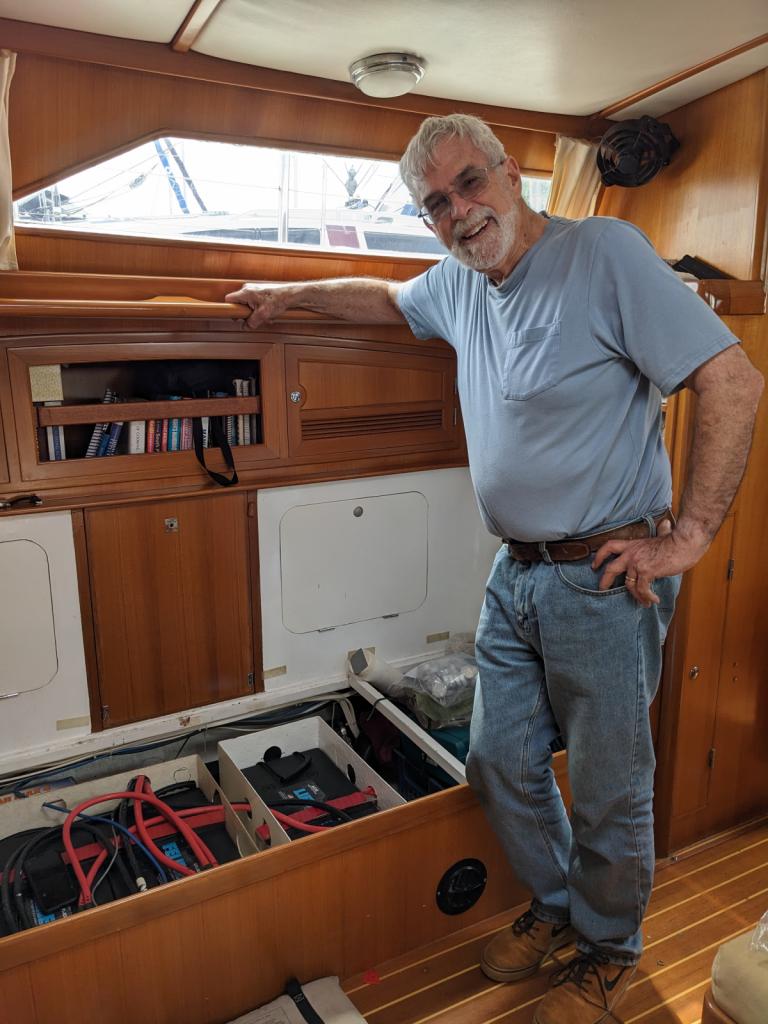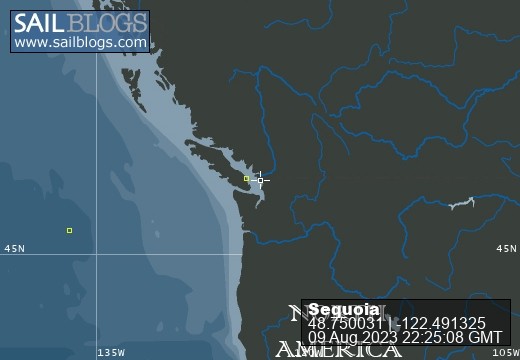
Sequoia Changing Latitudes
30 August 2023 | St. Helens, Oregon
09 August 2023 | Bellingham, Washington
21 July 2023 | Boat: Bellingham; C&B: Scappoose
10 July 2023 | Egmont, Sunshine Coast, B.C., Canada
02 July 2023 | Walsh Cove, Desolation Sound, B.C., Canada
23 June 2023 | Westview/Powell River B.C.
18 June 2023 | Ganges, Saltspring Island, B.C., Canada
22 June 2019 | Scappoose, Oregon
27 May 2019 | Back home in Oregon
09 May 2019 | Villas Alturas Hotel, Costa Rica
02 May 2019 | San Vito, Costa Rica
23 April 2019 | Golfito, Costa Rica
11 April 2019 | Panama City, Panama
04 April 2019 | Shelter Bay Marina, Colon, Panama
22 March 2019 | Jamaica
11 March 2019 | Zar Par Marina, Boca Chica, Dominican Republic
18 February 2019 | Culebra Island, Puerto Rico
31 January 2019 | Simpson Bay Lagoon, Sint Maarten
21 January 2019 | Nelson's Dockyard, English Harbour, Antigua
04 January 2019 | Portsmouth, Dominica
Docking in the Baltic
23 June 2017 | Karlskrona, Sweden
Barbara/warm and sunny
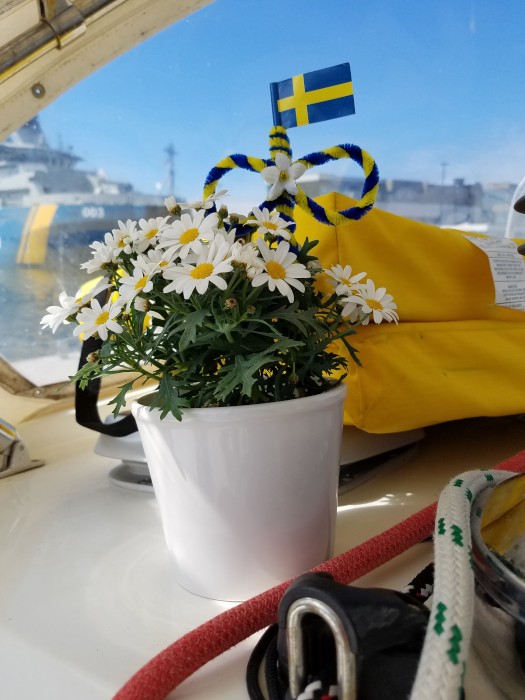
We've just arrived in Karlskrona, Sweden to celebrate Midsummer with our friends Lennart and Solveig Olsson. We're looking forward to renewing a warm friendship and sharing Swedish experiences together. But I've fallen behind on my blog submissions, so I'll take you back to the beginning of our time in Denmark (only a week ago!), and catch up as quickly as I can. So much happens that is new and interesting that it's hard to find time to stop and record our experiences and memories.
For me, the challenges of docking the boat Baltic style have been a worry. So I'm going to talk about that for a bit, and then we'll get back to the fun stuff. If you're not a sailor, and you're not interested in boat handling, I suggest you skip ahead until you see, at the beginning of a paragraph, "BUT LET ME DIVERGE..."
As part of our planning for this trip, I spent a lot of time on the internet, looking at possible destinations, including photos of marinas. Google Earth allows you to see what the harbors look like from overhead, including type and size of boat, and what the docking arrangements are. Most Baltic Sea marinas have the sailboats with their bow (front end) to the dock, and stern (rear end) tied to two pilings. Each boat appears to touch or almost touch the boat next to it.
So how do you get off? I contemplated this for awhile, then did some research and found out that sailboats in the Baltic have an open bow pulpit, often with wooden steps for climbing off. One cruising guide said we would need to have a ladder to get down from the bow onto the dock. There are other docking systems too; one involves floating pontoons that won't carry the weight of a person; another involves picking up a slimy rope off the bottom that you tie to your boat (ew!) There seem to be variants of each system.
Apparently these different systems are easier and cheaper for the marina owners, and they work because the Baltic has tides of less than a foot, making it more or less like a lake. So they can build fixed docks onto pilings instead of having floats that ride up and down the pilings like we have in the Pacific Northwest. Then they build one of these docking systems and I guess all the folks around the Baltic learn to do it.
Climbing down from the bow pulpit sounded mighty acrobatic, and I couldn't picture how we would do it with our closed bow pulpit and no such ladder. We discussed it, and decided there must be a way to do it, and we would just improvise when the time came.
We first saw Baltic style docking in Brunsbüttl, just inside the entrance to the Kiel Canal. Each boat nosed up to a concrete quay and tied a stern line to a big orange buoy. The boat owners climbed off the front end onto the quay. Fortunately that marina also had some side-tie spots available for larger boats (which we are). After that, I think our mantra had become: "Please, let there be side tie space available!"
We found side-tie space in Kiel, on the dock with the six or seven historic Dutch sailing ships. And we looked for, and found, side tie space in Maasholm, where we spent a couple of days with Cori's family. But it was only matter of time until we had to face the inevitable and wind up in a harbor with no side tie available.
We looked with interest at how the Kosyna family boat was tied up in Arnis, in the typical Baltic method. We had a chance to go on their boat, and experience the Baltic-style on-off system through the open bow pulpit. It turns out that there is no need for any ladder, because the dock is set at a height that is just a few inches below the bow of a middle-size sailboat. This began to seem possible.

Above: Cori at the bow of the Kosyna sailboat Butje in Arnis.
In Baltic-style moorage, the space for the boat is called a "box" not a "berth". The front of the box is the dock, and the back of the box is the two pilings. You have to go between the two pilings to get into the box. Cori told us that it is common to have to push the two pilings apart a bit to get between them, so the pilings often scrape along the side of the boat. Cori pointed out that almost all the sailboats have sacrificial rub rails on their boats. An extra strip of wood is often used, or a strip of rubber that sticks out farther than the side of the boat. We saw some boats that had thick sections of rope added along their toe rail. We decided that we might be able to figure out how to do the rope thing, and indeed, at a chandler in Kappeln, Craig found such ropes available, 240 Euros ($290) for the pair of them. Yikes! (But, we decided, cheaper than the boat repairs we would have to do after only a few such scrapes.) So we bought and have now installed them.

Above: Sequoia with her rub-rail-substitute ropes.
As I described in our last blog post, we said good-bye to the Kosynas and headed for Marstal on the island of Aerø, Denmark. We knew that we would have to face "the box" for sure there. Craig called ahead to ask if by any chance they had any side-ties available, but no, box berth it is. In this particular case we didn't have to worry about poles that were too close together, because the guest "boxes" radiated like petals on a daisy from a circular dock, making the back of the box wider than the front.
We hadn't counted on the wind being as strong as it was. We got one line around one piling and almost got the bow up to the dock, but weren't able to get a line onto the dock. Unexpectedly the cleats were not cleats but instead giant inverted U-shaped staples. The wind blew the bow off, and now all of a sudden we were sideways in the space. Fortunately a Norwegian guy on the dock offered to help, although as it turns out, we couldn't get a line to him. Then a small boat came along and was able to carry our bow line to the Norwegian guy, and we managed to get the boat docked. We figured out how to climb on and off the bow pulpit, and all was good. We felt somewhat better when the two boats that came in after us (both regular Baltic sailors, one from Germany and another from Denmark) had great difficulty getting docked in that wind. In each case a lot of help was required from adjacent boats (including us).

Above: Sequoia at the dock in Marstal, Aerø, Denmark.
BUT LET ME DIVERGE from the docking question, and get to the fun parts of our trip. We are seeing beautiful, historic places and meeting all sorts of interesting people. After the very interesting docking exercise at Marstal, we invited the Norwegian guy (Per-Arne) who had helped with our docking, and his wife (Kari-Anne), over to the boat for snacks and a drink. It turns out they just shipped their boat back from the Caribbean after spending seven years there. We talked about the unique position of Norway in the world economy, as well as the challenges of US politics at the present time. The next morning we heard a rap on the bow of our boat and a very gregarious couple introduced themselves. She, Karen, was an American who had been living in France all of her adult life, and her companion (the boat owner, Jean-Luc) was a French guy. They had gone through the Kiel Canal entrance lock with us, unbeknownst to us. Karen had noticed that we were an American boat - being American is pretty unusual around here - we have yet to see another boat with an American flag. We have been traveling more or less along the same path, and Karen has wanted to say hello. They had spotted us on their AIS receiver. Although both of our boats were docked on the island of Aerø, they were in different harbors. So Karen and Jean-Luc hopped on the free bus between the harbors and came down to find us.
We had a delightful conversation with Karen and Jean-Luc (verging into US and international politics, as we do with most Europeans), and they invited us to join them for lunch the next day in Aerøskoeping (their harbor). It seemed like a good opportunity, so we gladly accepted.
Marstal is a shipbuilding town with an interesting collection of old houses and a maritime museum. The iconic beach cottage that is on the cover of the current Denmark Lonely Planet guide is just south of Marstal - we could see it from our boat. We bought some strawberries from a sidewalk "honesty" stand (there seem to be lots of those this time of year, mostly featuring strawberries, jam and new potatoes.) We got to be pretty good at climbing off the bow of the boat onto the dock and enjoyed exploring the town.
The next day we took the free bus over to Aerøskoeping, which is described by the guide books as a "fairy tale" town. The very old houses are beautiful to look at, and full of interesting shops. We ate lunch with Karen and Jean-Luc at a very elegant French-style restaurant, very expensive, as it turned out. (We have found out throughout our time in Denmark that food is expensive here, particularly for the tourists.)
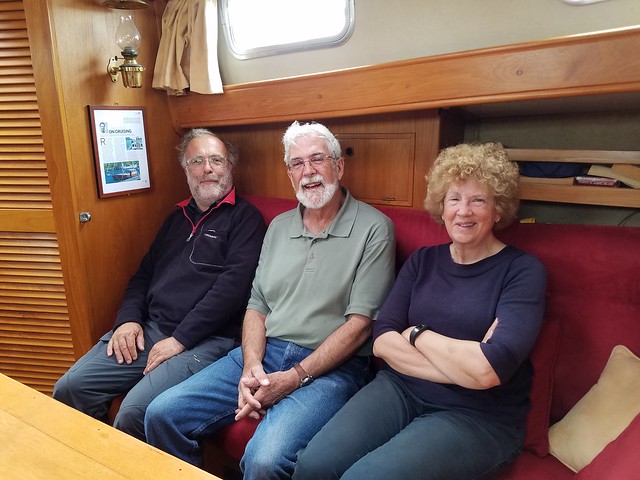
Above: Karen and Jean-Luc, with Craig, aboard their boat.
The bus trip to Aerøskoeping and back took us through rolling hills of agricultural country. The island of Aerø has set the goal to become energy independent by 2025, and we rolled past their six giant wind turbines and fields of photovoltaic panels and solar water heating panels. It seems like they are on track to reach their goal.
The box berth at Marstal was less difficult (but not easy) to leave than it had been to arrive. The problem in this case was that the area behind the berth (where we needed to back and turn) was only about 20 feet wide before it started to lose depth. Once again we envied the European boats with their bow thrusters, who can turn in a much tighter radius than we can. We stirred up a lot of mud but didn't actually touch bottom, and then we were headed for our next Danish destination, Gedser.
Gedser is on the island of Falster (which sounds like it might be a line from an opera where the soprano is accusing the tenor of being a scurrilous liar: "Falster!") Never mind, Gedser appears to be a delightful place, although we didn't spend long there. We came in, found a side tie, and secured ourselves to the dock with the assistance of several other boaters there. After we arrived there was a steady stream of sailboats arriving and looking for a side tie. We were glad to have arrived and found one of the few available. Nearly all the boats were German, and nearly all of those were charter boats. Typically it was six guys (an occasional lone woman) all decked out in full foul weather gear. The weather was pleasant and warm, and we were in our shorts. They energetically attacked the various tasks of docking and must have been sweltering in their foul weather gear. Apparently Gedser is one day's easy sail from a chartering base in Germany. Some of the boats were out for 4 days of what is apparently a long weekend in Germany. They were all headed elsewhere early the next morning.
There was no harbor master on site in Gedser, so we dealt with the very complicated machine we have seen in several other marinas. It asks you various questions about your length, width, number of nights (sometimes number of people aboard) and then takes a credit card. Typically, then, it issues a sticker for the boat, a receipt, and a key card for the onshore facilities which carries a refundable deposit and an amount to spend on showers and perhaps electricity. If you're lucky, the machine has a button marked with a Union Jack, so it will give you your instructions in English (or at least something that has been machine-translated into English). When you leave, if you're lucky, you can stick the key card back in the machine and it will refund the deposit and any balance onto your credit card. Pretty cool if it all works (which it did in Gedser).
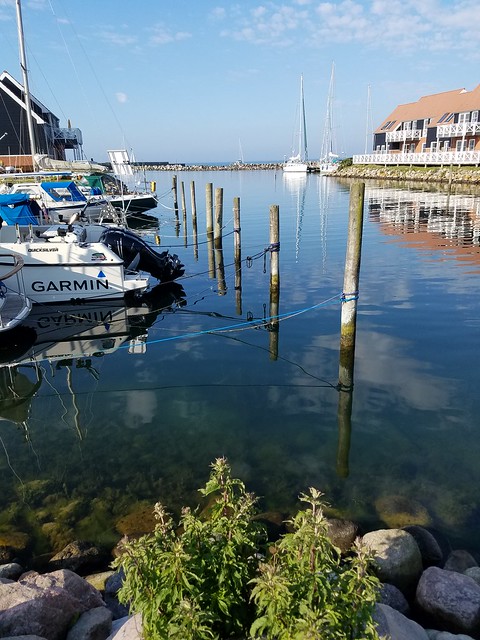
Above: Klintholm, Sequoia is side-tied at the distant dock. The boats on the left are in typical Baltic mooring "boxes". Stern tied to pilings, bow nosed up to the dock.
We only stayed overnight in Gedser because we wanted to have a longer time in Møn. So we left early the next morning and made the relatively short passage, arriving at Klintholm, Møn in the early afternoon. Klintholm Havn was originally built in the late nineteenth century as a port for shipping out natural resources from the Klintholm Estate. More recently it has been made into a resort, both for visiting yachts and for land-based travelers. As such it has nice facilities, but there is no real town nearby. The little grocery store caters to tourists and there are three fairly expensive restaurants. We ate at one of them, that for 189 Danish kroner (~US$29) offered a seafood buffet. Many kinds of Danish fish, including poached salmon, wolf fish drowned in onions, breaded deep fried patties made from ground fish, pickled herring, fried "plaice" (which appears to be a form of flatfish related to sole), and a fish soup (with small oysters) which was absolutely delicious. There were also various salads and several different kinds of potatoes. The restaurant looked out over the harbor, so was a very pleasant dinner setting.
At the restaurant, we were approached by a fellow sailor from the sailboat Intention, who said he had seen us at the Dutch island of Vlieland, where we were all hunkered down waiting out the big storm. We invited him, Jan-Bernard and his son, Pieter to come aboard Sequoia for an after-dinner drink. We learned that they were from Utrecht, Holland, and they were planning a trip more or less like ours: north through the Swedish islands, Stockholm, and then through the Gøta Canal to Gothenburg. From Gothenburg they'll head south back to Utrecht, and they are allowing a month to make it back, to account for likely adverse weather and winds. We got to talking about our plans allowing only two weeks from Gothenburg to get to Portsmouth, England, and it has certainly gotten us thinking about whether we should allow more time, or consider again the possibility of leaving the boat somewhere on the Baltic for the winter, rather than trying to make it to England. We'll be thinking a lot about that.
As with other guests on our boat, conversation turned to politics, and we talked a lot about what the future may hold. I expect we'll be seeing Jan-Bernard and Pieter again during our trip, and that will be lovely.

Above: The cliffs of Møn
Our next passage in Denmark would be over 75 miles, so we decided to do an overnight passage. We left Klintholm at 6 in the evening, motored over to the Cliffs of Møn, and anchored for dinner. The Cliffs of Møn are upthrust chalk cliffs and are quite spectacular. We sat there in the evening sun and enjoyed a delightful dinner. After washing up, we got started on our night passage to Bornholm. Mine was the first watch, and it was beautiful watching the sun go down at close to 10 pm on this nearly longest day of the year. The sun goes down quite diagonally, and it must take 15 or 20 minutes between the time its lower edge hits the ocean and the time the upper edge slides out of sight. That northern horizon never really gets dark during the night, and the sun comes up again at about 4 am just a bit further to the east along the same northern horizon.
This blog entry has gotten way too long, so I think I'll leave you there, and we'll continue with the arrival in Bornholm and beyond in a later submission.
Click here for more pictures of docking in the Baltic Sea
Click here for more pictures of the Danish Islands.

Above: Sunset on nearly the longest day of the year, as Sequoia travels from Møn to Bornholm.
For me, the challenges of docking the boat Baltic style have been a worry. So I'm going to talk about that for a bit, and then we'll get back to the fun stuff. If you're not a sailor, and you're not interested in boat handling, I suggest you skip ahead until you see, at the beginning of a paragraph, "BUT LET ME DIVERGE..."
As part of our planning for this trip, I spent a lot of time on the internet, looking at possible destinations, including photos of marinas. Google Earth allows you to see what the harbors look like from overhead, including type and size of boat, and what the docking arrangements are. Most Baltic Sea marinas have the sailboats with their bow (front end) to the dock, and stern (rear end) tied to two pilings. Each boat appears to touch or almost touch the boat next to it.
So how do you get off? I contemplated this for awhile, then did some research and found out that sailboats in the Baltic have an open bow pulpit, often with wooden steps for climbing off. One cruising guide said we would need to have a ladder to get down from the bow onto the dock. There are other docking systems too; one involves floating pontoons that won't carry the weight of a person; another involves picking up a slimy rope off the bottom that you tie to your boat (ew!) There seem to be variants of each system.
Apparently these different systems are easier and cheaper for the marina owners, and they work because the Baltic has tides of less than a foot, making it more or less like a lake. So they can build fixed docks onto pilings instead of having floats that ride up and down the pilings like we have in the Pacific Northwest. Then they build one of these docking systems and I guess all the folks around the Baltic learn to do it.
Climbing down from the bow pulpit sounded mighty acrobatic, and I couldn't picture how we would do it with our closed bow pulpit and no such ladder. We discussed it, and decided there must be a way to do it, and we would just improvise when the time came.
We first saw Baltic style docking in Brunsbüttl, just inside the entrance to the Kiel Canal. Each boat nosed up to a concrete quay and tied a stern line to a big orange buoy. The boat owners climbed off the front end onto the quay. Fortunately that marina also had some side-tie spots available for larger boats (which we are). After that, I think our mantra had become: "Please, let there be side tie space available!"
We found side-tie space in Kiel, on the dock with the six or seven historic Dutch sailing ships. And we looked for, and found, side tie space in Maasholm, where we spent a couple of days with Cori's family. But it was only matter of time until we had to face the inevitable and wind up in a harbor with no side tie available.
We looked with interest at how the Kosyna family boat was tied up in Arnis, in the typical Baltic method. We had a chance to go on their boat, and experience the Baltic-style on-off system through the open bow pulpit. It turns out that there is no need for any ladder, because the dock is set at a height that is just a few inches below the bow of a middle-size sailboat. This began to seem possible.

Above: Cori at the bow of the Kosyna sailboat Butje in Arnis.
In Baltic-style moorage, the space for the boat is called a "box" not a "berth". The front of the box is the dock, and the back of the box is the two pilings. You have to go between the two pilings to get into the box. Cori told us that it is common to have to push the two pilings apart a bit to get between them, so the pilings often scrape along the side of the boat. Cori pointed out that almost all the sailboats have sacrificial rub rails on their boats. An extra strip of wood is often used, or a strip of rubber that sticks out farther than the side of the boat. We saw some boats that had thick sections of rope added along their toe rail. We decided that we might be able to figure out how to do the rope thing, and indeed, at a chandler in Kappeln, Craig found such ropes available, 240 Euros ($290) for the pair of them. Yikes! (But, we decided, cheaper than the boat repairs we would have to do after only a few such scrapes.) So we bought and have now installed them.

Above: Sequoia with her rub-rail-substitute ropes.
As I described in our last blog post, we said good-bye to the Kosynas and headed for Marstal on the island of Aerø, Denmark. We knew that we would have to face "the box" for sure there. Craig called ahead to ask if by any chance they had any side-ties available, but no, box berth it is. In this particular case we didn't have to worry about poles that were too close together, because the guest "boxes" radiated like petals on a daisy from a circular dock, making the back of the box wider than the front.
We hadn't counted on the wind being as strong as it was. We got one line around one piling and almost got the bow up to the dock, but weren't able to get a line onto the dock. Unexpectedly the cleats were not cleats but instead giant inverted U-shaped staples. The wind blew the bow off, and now all of a sudden we were sideways in the space. Fortunately a Norwegian guy on the dock offered to help, although as it turns out, we couldn't get a line to him. Then a small boat came along and was able to carry our bow line to the Norwegian guy, and we managed to get the boat docked. We figured out how to climb on and off the bow pulpit, and all was good. We felt somewhat better when the two boats that came in after us (both regular Baltic sailors, one from Germany and another from Denmark) had great difficulty getting docked in that wind. In each case a lot of help was required from adjacent boats (including us).

Above: Sequoia at the dock in Marstal, Aerø, Denmark.
BUT LET ME DIVERGE from the docking question, and get to the fun parts of our trip. We are seeing beautiful, historic places and meeting all sorts of interesting people. After the very interesting docking exercise at Marstal, we invited the Norwegian guy (Per-Arne) who had helped with our docking, and his wife (Kari-Anne), over to the boat for snacks and a drink. It turns out they just shipped their boat back from the Caribbean after spending seven years there. We talked about the unique position of Norway in the world economy, as well as the challenges of US politics at the present time. The next morning we heard a rap on the bow of our boat and a very gregarious couple introduced themselves. She, Karen, was an American who had been living in France all of her adult life, and her companion (the boat owner, Jean-Luc) was a French guy. They had gone through the Kiel Canal entrance lock with us, unbeknownst to us. Karen had noticed that we were an American boat - being American is pretty unusual around here - we have yet to see another boat with an American flag. We have been traveling more or less along the same path, and Karen has wanted to say hello. They had spotted us on their AIS receiver. Although both of our boats were docked on the island of Aerø, they were in different harbors. So Karen and Jean-Luc hopped on the free bus between the harbors and came down to find us.
We had a delightful conversation with Karen and Jean-Luc (verging into US and international politics, as we do with most Europeans), and they invited us to join them for lunch the next day in Aerøskoeping (their harbor). It seemed like a good opportunity, so we gladly accepted.
Marstal is a shipbuilding town with an interesting collection of old houses and a maritime museum. The iconic beach cottage that is on the cover of the current Denmark Lonely Planet guide is just south of Marstal - we could see it from our boat. We bought some strawberries from a sidewalk "honesty" stand (there seem to be lots of those this time of year, mostly featuring strawberries, jam and new potatoes.) We got to be pretty good at climbing off the bow of the boat onto the dock and enjoyed exploring the town.
The next day we took the free bus over to Aerøskoeping, which is described by the guide books as a "fairy tale" town. The very old houses are beautiful to look at, and full of interesting shops. We ate lunch with Karen and Jean-Luc at a very elegant French-style restaurant, very expensive, as it turned out. (We have found out throughout our time in Denmark that food is expensive here, particularly for the tourists.)

Above: Karen and Jean-Luc, with Craig, aboard their boat.
The bus trip to Aerøskoeping and back took us through rolling hills of agricultural country. The island of Aerø has set the goal to become energy independent by 2025, and we rolled past their six giant wind turbines and fields of photovoltaic panels and solar water heating panels. It seems like they are on track to reach their goal.
The box berth at Marstal was less difficult (but not easy) to leave than it had been to arrive. The problem in this case was that the area behind the berth (where we needed to back and turn) was only about 20 feet wide before it started to lose depth. Once again we envied the European boats with their bow thrusters, who can turn in a much tighter radius than we can. We stirred up a lot of mud but didn't actually touch bottom, and then we were headed for our next Danish destination, Gedser.
Gedser is on the island of Falster (which sounds like it might be a line from an opera where the soprano is accusing the tenor of being a scurrilous liar: "Falster!") Never mind, Gedser appears to be a delightful place, although we didn't spend long there. We came in, found a side tie, and secured ourselves to the dock with the assistance of several other boaters there. After we arrived there was a steady stream of sailboats arriving and looking for a side tie. We were glad to have arrived and found one of the few available. Nearly all the boats were German, and nearly all of those were charter boats. Typically it was six guys (an occasional lone woman) all decked out in full foul weather gear. The weather was pleasant and warm, and we were in our shorts. They energetically attacked the various tasks of docking and must have been sweltering in their foul weather gear. Apparently Gedser is one day's easy sail from a chartering base in Germany. Some of the boats were out for 4 days of what is apparently a long weekend in Germany. They were all headed elsewhere early the next morning.
There was no harbor master on site in Gedser, so we dealt with the very complicated machine we have seen in several other marinas. It asks you various questions about your length, width, number of nights (sometimes number of people aboard) and then takes a credit card. Typically, then, it issues a sticker for the boat, a receipt, and a key card for the onshore facilities which carries a refundable deposit and an amount to spend on showers and perhaps electricity. If you're lucky, the machine has a button marked with a Union Jack, so it will give you your instructions in English (or at least something that has been machine-translated into English). When you leave, if you're lucky, you can stick the key card back in the machine and it will refund the deposit and any balance onto your credit card. Pretty cool if it all works (which it did in Gedser).

Above: Klintholm, Sequoia is side-tied at the distant dock. The boats on the left are in typical Baltic mooring "boxes". Stern tied to pilings, bow nosed up to the dock.
We only stayed overnight in Gedser because we wanted to have a longer time in Møn. So we left early the next morning and made the relatively short passage, arriving at Klintholm, Møn in the early afternoon. Klintholm Havn was originally built in the late nineteenth century as a port for shipping out natural resources from the Klintholm Estate. More recently it has been made into a resort, both for visiting yachts and for land-based travelers. As such it has nice facilities, but there is no real town nearby. The little grocery store caters to tourists and there are three fairly expensive restaurants. We ate at one of them, that for 189 Danish kroner (~US$29) offered a seafood buffet. Many kinds of Danish fish, including poached salmon, wolf fish drowned in onions, breaded deep fried patties made from ground fish, pickled herring, fried "plaice" (which appears to be a form of flatfish related to sole), and a fish soup (with small oysters) which was absolutely delicious. There were also various salads and several different kinds of potatoes. The restaurant looked out over the harbor, so was a very pleasant dinner setting.
At the restaurant, we were approached by a fellow sailor from the sailboat Intention, who said he had seen us at the Dutch island of Vlieland, where we were all hunkered down waiting out the big storm. We invited him, Jan-Bernard and his son, Pieter to come aboard Sequoia for an after-dinner drink. We learned that they were from Utrecht, Holland, and they were planning a trip more or less like ours: north through the Swedish islands, Stockholm, and then through the Gøta Canal to Gothenburg. From Gothenburg they'll head south back to Utrecht, and they are allowing a month to make it back, to account for likely adverse weather and winds. We got to talking about our plans allowing only two weeks from Gothenburg to get to Portsmouth, England, and it has certainly gotten us thinking about whether we should allow more time, or consider again the possibility of leaving the boat somewhere on the Baltic for the winter, rather than trying to make it to England. We'll be thinking a lot about that.
As with other guests on our boat, conversation turned to politics, and we talked a lot about what the future may hold. I expect we'll be seeing Jan-Bernard and Pieter again during our trip, and that will be lovely.

Above: The cliffs of Møn
Our next passage in Denmark would be over 75 miles, so we decided to do an overnight passage. We left Klintholm at 6 in the evening, motored over to the Cliffs of Møn, and anchored for dinner. The Cliffs of Møn are upthrust chalk cliffs and are quite spectacular. We sat there in the evening sun and enjoyed a delightful dinner. After washing up, we got started on our night passage to Bornholm. Mine was the first watch, and it was beautiful watching the sun go down at close to 10 pm on this nearly longest day of the year. The sun goes down quite diagonally, and it must take 15 or 20 minutes between the time its lower edge hits the ocean and the time the upper edge slides out of sight. That northern horizon never really gets dark during the night, and the sun comes up again at about 4 am just a bit further to the east along the same northern horizon.
This blog entry has gotten way too long, so I think I'll leave you there, and we'll continue with the arrival in Bornholm and beyond in a later submission.
Click here for more pictures of docking in the Baltic Sea
Click here for more pictures of the Danish Islands.

Above: Sunset on nearly the longest day of the year, as Sequoia travels from Møn to Bornholm.
Comments
| Vessel Name: | Sequoia |
| Vessel Make/Model: | Outbound 44 |
| Hailing Port: | Portland, Or |
| Crew: | Craig & Barbara Johnston |
| About: | |
| Extra: |
Sequoia's Photos - Main
Who we are...
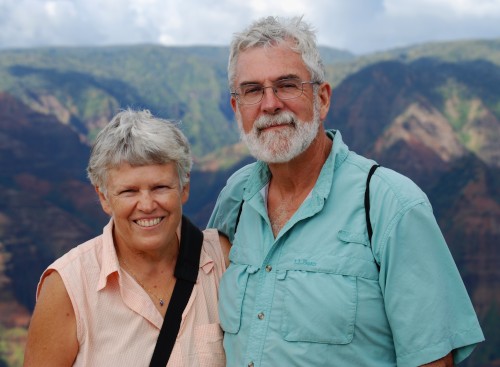
Who: Craig & Barbara Johnston
Port: Portland, Or
